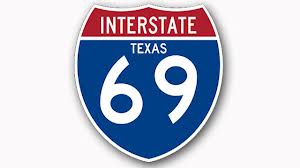Best have your tinfoil hat at the ready.
The first Houston-area piece of a trade corridor — debated for more than a decade and envisioned as one day linking Mexico to Canada — has been officially designated.
Motorists will soon notice new road signs naming a 35-mile stretch of existing U.S. 59, from the 610 Loop to FM 787 in Cleveland, as part of the new Interstate 69.
With little fanfare, the Texas Transportation Commission recently voted to put up the new signage while keeping the U.S. 59 designation.
The I-69 corridor, the so-called NAFTA Superhighway that is supposed to connect the Texas-Mexico border to America’s heartland, has been on the drawing board since at least 2002. Plans to make the corridor wide enough to include tollways, rail and utility lines were phased out in 2009 in favor of a more traditional corridor that will be built in small increments.
The project has met with opposition from farmers and ranchers championing private property rights and others who opposed a large toll-road component of the plan.
That’s one way of putting it. There’s already a seven-mile stretch of highway down by Corpus Christi that has the I-69 designation, and according to Wikipedia there are little bits of I-69 in other states as well. If you’re unsure what I mean by the “tinfoil hat” remark, I suggest you spend a few minutes Googling “NAFTA superhighway”; all will be abundantly clear. Or just spend a few minutes giggling like a schoolboy about the new name. Either way it’s not likely to make too much difference in your daily life, but at least now you know.
You should also plan to drive on I-69 sooner rather than later, because it’s gonna get crowded pretty quick.
As the transformation of U.S. 59 in Houston to Interstate 69 continues, projections show an increase in traffic of up to 150 percent by 2035. Experts say traffic will increase regardless of whether the so-called NAFTA Superhighway, envisioned two decades ago as a trade route from Mexico through Houston to Canada, is fully built.
[…]
Houston’s segment, which already experiences traffic pileups and is not scheduled for any expansion under the plan, would be hit with the largest increase in traffic volume on Texas’ interstate route.
“But that traffic is coming to us no matter what we do. We are going to see a huge increase in freight — more than 300 percent in a little over a decade,” said a committee member, Ashby Johnson, the Houston-Galveston Area Council’s deputy transportation director. “Some of it is coming from NAFTA and some of it’s from the widening of the Panama Canal.”
Imagine how nasty the northbound approach to I-45 will be by then. Naturally, there’s no plan to deal with it. If I’m still in the same office, I’ll definitely be taking the train to work by then. Thomas has more.

